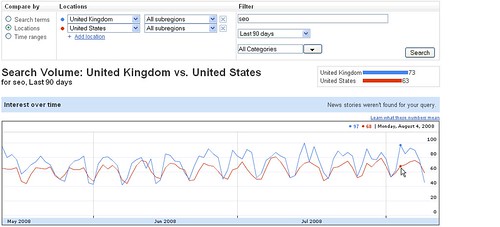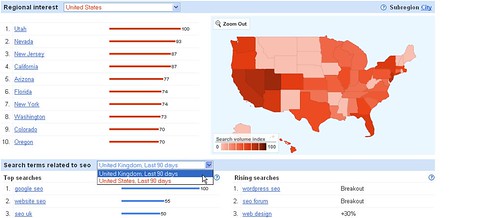After the success of Google Trends, the search giant has now launched a new tool, called ‘Google Insights For Search‘. This tool is similar to Trends, but shows rising searches in relation to other terms, geographic location and time periods.
Insights For Search adds to the bunch of new tools and features that Google has released in the past month. It is supposed to enable AdWords advertisers to understand search better. However, closer inspection makes it seem more like a repackaging of already available data with some pretty graphs.
An advertiser interested in selling a product or service, say SEO, could type in the search term “seo” to study search volume patterns across a given time period. The data can be compared for various geographical markets, as shown below:

The advertiser can also see the top and rising related searches and to compare search volumes across multiple local markets within each of the geographical locations being compared.

For the statistics and trivia buffs, Google Insights For Search also includes the ability to compare trends for multiple search terms…

… and the ability to compare trends for a search term over multiple periods of time.

Users can download the results from this service and view the numbers on the graph by signing into their Google account. The numbers on the graphs, though, are rather useless for most real purposes. In Google’s own words, “The numbers on the graph reflect how many searches have been done for a particular term, relative to the total number of searches done on Google over time. They don’t represent absolute search volume numbers, because the data is normalised and presented on a scale from 0-100”.
The same information, minus the pretty graphs and maps with hotspots, can be found from the Google keyword tool, with the added benefit of now including real search volumes. It seems rather unlikely that this tool will be used to a great extent by savvy search marketers.
Graphical representation of data, easy correlation of geographical distribution (in spite of rather dubious results in the UK) and comparison to other related terms might appeal to Internet marketing novices and traditional media executives who have begun dabbling in search, which seem to be Google’s new target market.









